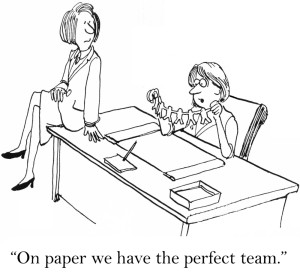
For a team to become high performing, it must have the right team members in the first place.The three biggest mistakes I observe many leaders make in assembling the right team are:
1. Settling for the team they have, even though deep down they know it doesn’t have all the right team members
2. Taking far too long to make the necessary changes
3. Not providing the necessary support to help someone become the “right” team member
Here are some ideas on how to overcome the above mistakes.
1. Decide if changes are required
To determine if you have your “A” team, start by answering the following 3 questions for each member of your team:
1. Do they have the required mind-set and skill-set to do the job/role?
2. Does a big part (60%+) of their job/role align to:
- their passions (i.e. what they love doing) and,
- their strengths (i.e. what they are good at)
3. Are they a good team player?
Once you’ve answered the above questions, you should be in a position to categorise each member of your team into the following three buckets:
- Definitely keep
- Definitely transition out
- Not sure
For anyone that you are unsure about, here is one more question to answer:
“With all things considered, if there were no constraints and the decision was entirely yours, would you hire this person again for this job/role?”
If the answer to this is “Yes”, then you need to ask yourself:
- What’s causing you to be unsure?
- What needs to happen for you to firm up your view?
- By when would you decide?
- What will you do next?
If, however, the answer to this is “No”, then you must act.
2. Make the changes fast
Once you know who needs to be transitioned out of your team, you must move with speed to act on your decision. You obviously want to be fair and humane in doing so, and at the same time, its necessary you do it as quickly as possible. I often see leaders taking several months and years to make the required changes, which ultimately results in a lose-lose situation for everyone concerned.
3. Provide the necessary support to help the team members get better
This support could be in many forms, including:
- clarifying expectations
- mutually agreeing the areas that need to be improved and/or addressed
- helping them through: giving advice, demonstrating through examples, providing opportunities where they can safely practice etc
- having a specific plan to monitor progress and make adjustments along the way, including providing regular feedback
- getting them a coach they could work with
- adjusting your leadership style to bring out the best in them
What have been your experiences? Would love to hear what has and hasn’t worked for you.
